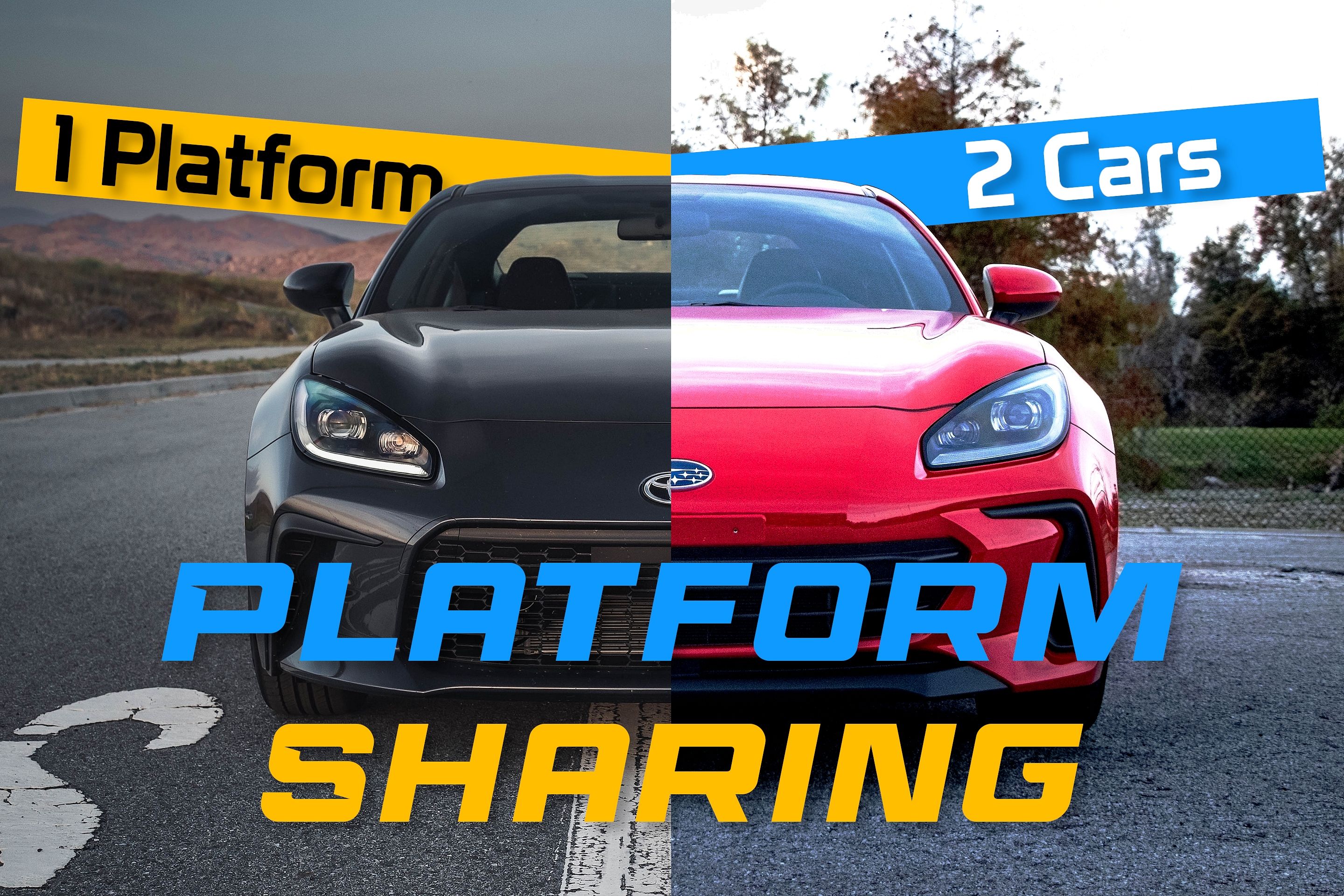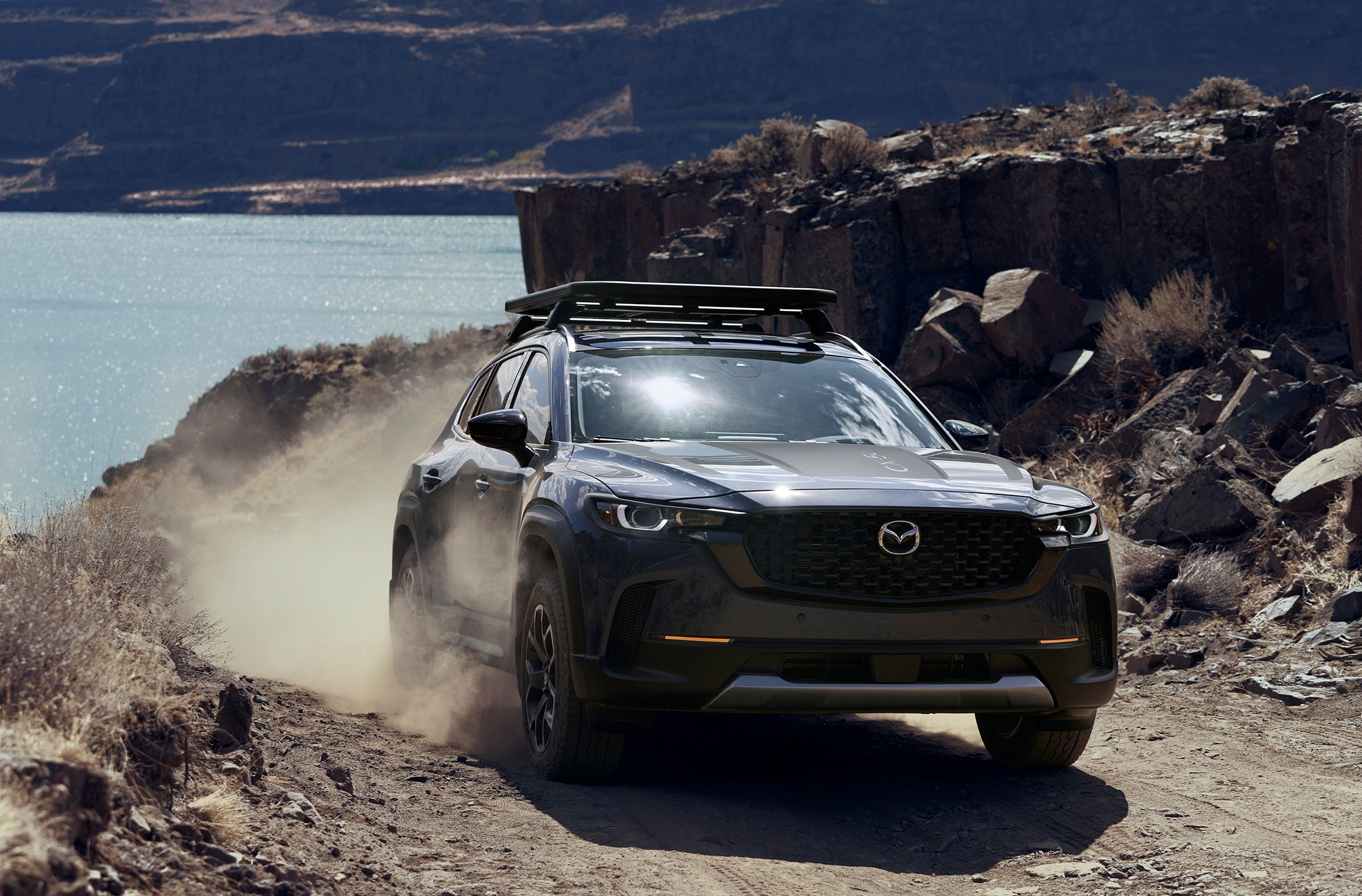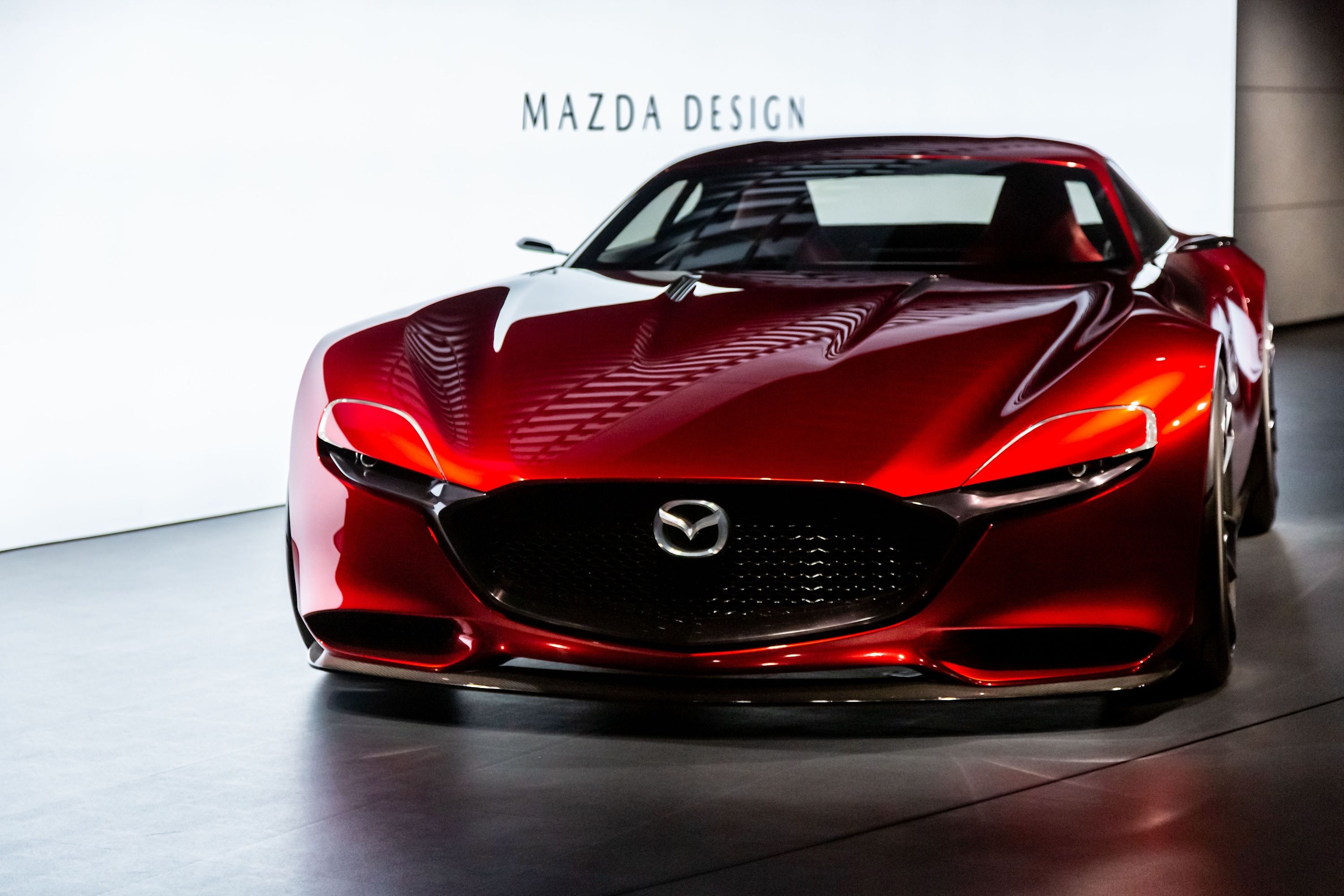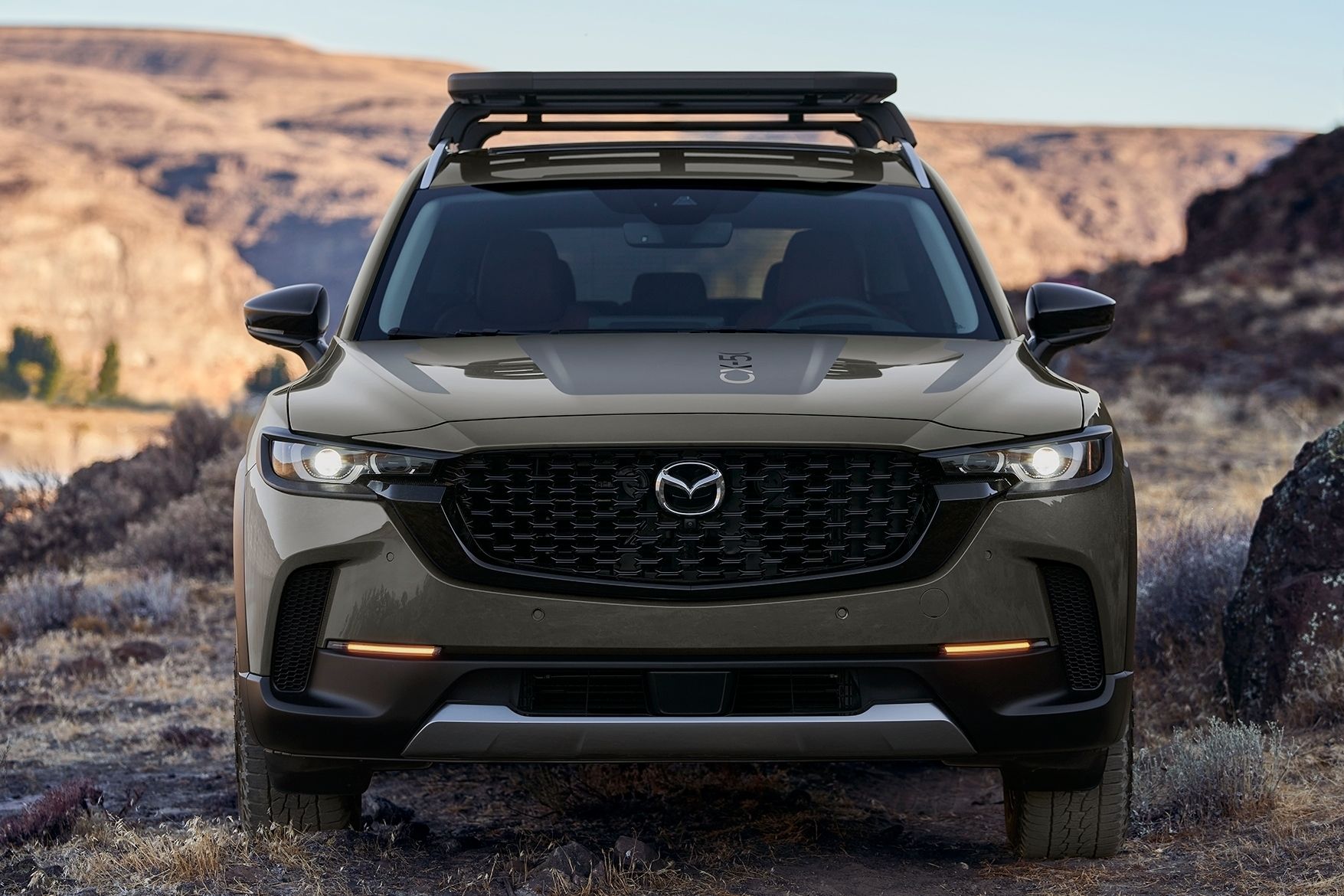Mazda’s SUV lineup has come a long way since the Navajo SUV, the spiritual predecessor to the CX-50, first debuted over 30 years ago. Starting in the early ’90s, the company supplemented its sedan/coupe/hatchback sales with a paltry list of badge-engineered Ford crossovers and SUVs for nearly two decades. Despite some early models garnering acclaim, it wasn’t until the company unveiled the CX-7 and CX-9 in the late 2000s that it started to find its stride in the family-hauling segment.

Related
The Good And Bad Of Platform Sharing And Badge Engineering
It does have its merits.
Today, Mazda boasts a lineup of exceptional products. From their designs to their driving characteristics, they consistently score at the top of their segments. Though models like the CX-5 are getting a bit long in the tooth, they still have lots to offer anyone looking for a capable vehicle that does almost everything. We wanted to lay out exactly how the different models stack up against one another, whether that be powertrain options, available seating, or sheer size. You really can’t go wrong with any of these crossovers. Just be prepared to reach deep in your pockets if you’re looking to get into their range toppers.
 Exteriors – Mazda’s Kodo Design Is Timeless
Exteriors – Mazda’s Kodo Design Is Timeless
The exterior is probably the best place to start, where Mazda has been doing an incredible job for the past decade making its offerings look stylish, attractive, and downright upmarket. The company’s Kodo or “Soul of Motion” design language has created a very consistent theme across its lineup, meaning whether you need seating for eight or just room for some extra luggage and your dog, you don’t need to sacrifice practicality for looks.
The potential problem is that this styling language worked when there were only two SUVs at opposite ends of the size spectrum, as each was easily differentiable. Now, the Mazda SUV lineup has started to look like a series of Russian nesting dolls, where they all look similar, but size is their only identifying characteristic to the uninitiated.

Related
5 Reasons Mazda Is Dominating Automotive Design Right Now
Whether it’s a compact two-seat sports car, a concept car, or a family SUV, Mazda seems incapable of releasing a design dud.
How Big Are Mazda’s SUVs?
As far as scale goes, the lineup from smallest to largest is as follows: CX-30, CX-5, CX-50, and CX-70/CX-90. The company surprised everyone with the debut of the CX-70 recently and its lack of differentiation from the CX-90. Really, they’re the same car, but one has fewer seats and is more expensive, making one wonder why it wasn’t just an option instead of an entirely new vehicle. All but the aging CX-5 are aligned with the new naming conventions. Between these five crossovers, Mazda occupies three distinct size segments of the market:
- Subcompact SUV: CX-30
- Compact SUV: CX-5, CX-50
- Midsize SUV: CX-70, CX-90
The EPA determines these classifications based on interior volumes, but interior volume is itself determined by the exterior footprint and dimensions of these crossovers:
|
Mazda SUV Exterior Measurements |
|||||
|---|---|---|---|---|---|
|
Model |
Length |
Wheelbase |
Height |
Max Width |
Curb Weight |
|
CX-30 |
173.0 inches |
104.4 inches |
61.7 inches |
70.7 inches |
3,424 lbs |
|
CX-5 |
180.1 inches |
106.2 inches |
66.1 inches |
72.6 inches |
3,728 lbs |
|
CX-50 |
185.8 inches |
110.8 inches |
63.5 inches |
75.6 inches |
3,706 lbs |
|
CX-70/CX-70 PHEV |
200.8 inches |
122.8 inches |
68.2 inches |
78.5 inches |
4,755 lbs/4,861 lbs |
|
CX-90/CX-90 PHEV |
200.8 inches |
122.8 inches |
68.2 inches |
78.5 inches |
4,885 lbs/5,236 lbs |
At the top of the range sits the CX-70 and CX-90, and they’re an exercise in “spot the difference.” Despite some exterior trim changes, they’re largely identical, right down to their dimensions, as shown above.
Interiors – On Par With High-End Luxury Brands
For a mainstream car brand, Mazda takes its interiors extremely seriously. This doesn’t mean they’re over the top, however. In fact, their interiors happen to be much more minimalist than their competitors. This is done on purpose to create a simplistic interface between the driver and the vehicle. The company isn’t interested in wowing the occupants with fancy gizmos or tricks as much as letting them admire the materials and quality and focus on the driving. Mazda is in the business of building driver’s cars, which is something usually associated with German luxury brands.
The benefit of this driver’s focus is the inclusion of many tactile dials and buttons to control the most common functions. For years, the company decided to place the screens high-up and away from the occupants, similar to what Audi has done in the past. Some models feature touchscreen capability, but controlling them with the dial is the easier option, and the only feature you’ll really use it for is music.
But while all are visually similar, they differentiate themselves practically in the number of occupants they can seat and the comfort of those occupants.
|
Mazda SUV Interior Comparison |
||||
|---|---|---|---|---|
|
Models |
Seating |
Headroom |
Legroom |
Trunk Space |
|
CX-30 |
5 |
38.1 inches front, 38.3 inches rear |
41.7 inches, front 36.3 inches rear |
20.2 – 45.2 ft³ |
|
CX-5 |
5 |
39.3-39.7 inches front, 39 inches rear |
41 inches front, 39.6 inches rear |
30 – 59.3 ft³ |
|
CX-50 |
5 |
38.6-39.1 inches front, 37.5-38.6 inches rear |
41.7 inches front, 39.8 inches rear |
31.4 – 56.3 ft³ |
|
CX-90 |
7-8 |
39.7 inches front, 39.3 inches second, 36.9 inches third |
41.7 inches front, 39.4 inches second, 30.4 inches third |
14.9 – 74.2 ft³ |
|
CX-70/CX-70 PHEV |
5 |
39.2 inches front, 38.6 inches second |
41.7 inches front, 39.4 inches second |
39.6 – 75.3 ft³ |
|
CX-90 & CX-90 PHEV |
7-8 |
39.2 inches front, 38.6 inches second, 36.9 inches third |
41.7 inches front, 39.4 inches second, 30.4 inches third |
14.9 – 74.2 ft³ |
Families of five and up should seriously consider the CX-70 and CX-90, given the extra space they offer. The CX-70 is strictly a five-seater, but the CX-90 gives you a choice between seating for seven or eight. As with many third rows in the upper midsize SUV segment, expect this to be reserved mainly for children and teens, with the capability of fitting an adult in a pinch.
Powertrains – Potent Engines Limited To Top-Spec Models
|
Mazda CX-30 |
Mazda CX-5 |
Mazda CX-50 |
||||
|---|---|---|---|---|---|---|
|
Engine |
2.5L I4 |
2.5L I4 Turbo |
2.5L I4 |
2.5L I4 Turbo |
2.5L I4 |
2.5L I4 Turbo |
|
Power |
191 hp |
250 hp |
187 hp |
256 hp |
187 hp |
256 hp |
|
Torque |
186 lb-ft |
320 lb-ft |
186 lb-ft |
320 lb-ft |
186 lb-ft |
320 lb-ft |
|
Transmission |
6-Speed Automatic |
|||||
|
Drivetrain |
AWD |
|||||
|
*Power and torque figures are manufacturer claims based on the maximum recommended octane fuel. |
||||||
Mazda has always been great about marrying its vehicles with compelling powertrains, but AWD and automatic transmissions are the only options across the lineup.
In the CX-30, CX-5, and CX-50, you get the choice of either a naturally aspirated 2.5-liter four-cylinder or turbocharged 2.5-liter four-cylinder engine mated to a six-speed automatic. The turbocharged engine is good for a seven-second 0-60 mph sprint in the CX-50, with the CX-5 doing a bit better in the mid-six-second range. The CX-30 is a real sleeper, however. Some independent tests have shown that it can sprint to 60 mph in less than six seconds.
The CX-70 and CX-90 don’t share powertrains with their lowly brethren. They’re the first Mazdas equipped with a 3.3-liter inline-six hybrid powertrain. Additionally, the company is offering a top-of-the-line plug-in hybrid that features a four-cylinder engine augmented by a single electric motor and a 17.8-kWh battery pack.
The inline-six comes in two flavors: S and non-S. On non-S models, the system produces 280 hp on regular gas, but on the S models, you get 340 hp when feeding it premium gas. These models come equipped with a more modern eight-speed automatic and are capable of reaching 0-60 in the low six-second range in the S models, so expect to hit that number around 7+ seconds in the non-S models. As for the PHEV, this is an entirely new animal from Mazda. It offers up to an EPA-estimated 25 miles of electric-only range, which can be recouped with a 120-volt charger or in 2.5 hours with a 240-volt charger. Despite its lower power figures, independent testing has found this model to be the fastest, managing 0-60 mph times a hair under six seconds.
|
Mazda CX-70 |
Mazda CX-90 |
|||||
|---|---|---|---|---|---|---|
|
Engine |
3.3L I6 Turbo Hybrid |
H/O 3.3L I6 Turbo Hybrid |
2.5L I4 PHEV |
3.3L I6 Turbo Hybrid |
H/O 3.3L I6 Turbo Hybrid |
2.5L I4 PHEV |
|
Power |
280 hp |
340 hp |
323 hp |
280 hp |
340 hp |
323 hp |
|
Torque |
332 lb-ft |
369 lb-ft |
369 lb-ft |
332 lb-ft |
369 lb-ft |
369 lb-ft |
|
Transmission |
8-Speed Automatic |
|||||
|
Drivetrain |
AWD |
|||||
|
*Power and torque figures are manufacturer claims based on the maximum recommended octane fuel. |
||||||
Fuel Economy – Not The Best, Not The Worst
Mazda is a company that focuses on the thrill of driving and compelling designs, and because of this, fuel economy has never seemed to be of the utmost priority until recently. You can blame this on thirsty engines and the older six-speed autos. Non-turbocharged models will return adequate to solid fuel economy, but if saving money at the pump is of the highest priority to you, then a Mazda crossover may not be the best option.
|
Mazda CX-30 |
Mazda CX-5 |
Mazda CX-50 |
||||
|---|---|---|---|---|---|---|
|
Engine |
2.5L I4 |
2.5L I4 Turbo |
2.5L I4 |
2.5L I4 Turbo |
2.5L I4 |
2.5L I4 Turbo |
|
City MPG |
26 MPG |
22 MPG |
23 MPG |
22 MPG |
24 MPG |
23 MPG |
|
Highway MPG |
33 MPG |
30 MPG |
29 MPG |
27 MPG |
30 MPG |
29 MPG |
|
Combined MPG |
29 MPG |
25 MPG |
25 MPG |
24 MPG |
27 MPG |
25 MPG |
|
*Fuel consumption figures sourced from the US EPA. |
||||||
Thanks to the hybrid system and new eight-speed auto, the CX-70 and CX-90’s base inline-six offers respectable fuel economy for its size, with the higher output version offering nearly identical fuel economy. The PHEV model then nets you an impressive 57 MPGe, which Mazda says should be good enough for a range of 490 miles.
|
Mazda CX-70 |
Mazda CX-90 |
|||||
|---|---|---|---|---|---|---|
|
Engine |
3.3L I6 Turbo Hybrid |
H/O 3.3L I6 Turbo Hybrid |
2.5L I4 PHEV |
3.3L I6 Turbo Hybrid |
H/O 3.3L I6 Turbo Hybrid |
2.5L I4 PHEV |
|
City MPG |
24 MPG |
23 MPG |
N/A |
24 MPG |
23 MPG |
N/A |
|
Highway MPG |
28 MPG |
28 MPG |
28 MPG |
28 MPG |
||
|
Combined MPG |
25 MPG |
25 MPG |
57 MPGe |
25 MPG |
25 MPG |
57 MPGe |
|
*Fuel consumption figures sourced from the US EPA. |
||||||
Towing – Adequate If You Go For Turbocharged Power
If you’re looking for vehicles that can tow, you should only be paying attention to the turbocharged CX-50 and up because, beneath that, there’s nothing special. Yeah, we don’t imagine too many people would be interested in towing a 30-footer with a CX-30, but the potent powertrains may fool you.
There’s a wide range of towing capacities covered by the Mazda SUV range, ranging from 1,500 pounds to 5,000 lbs. Naturally, smaller models tow less due to their lower GVWR, but let’s see how they stack up:
|
Mazda SUV Towing Capacity Chart |
|||||
|---|---|---|---|---|---|
|
2.5L Inline-4 Gas 6-Speed Automatic AWD |
2.5L Turbo Inline-4 Gas 6-Speed Automatic AWD |
3.3L Inline-6 Turbo Hybrid 8-Speed Automatic AWD |
High Output 3.3L Inline-6 Turbo Hybrid 8-Speed Automatic AWD |
2.5L Inline-4 PHEV Gas 8-Speed Automatic AWD |
|
|
CX-30 |
1,500 lbs |
2,000 lbs |
N/A |
N/A |
N/A |
|
CX-5 |
2,000 lbs |
2,000 lbs |
N/A |
N/A |
N/A |
|
CX-50 |
2,000 lbs |
3,500 lbs |
N/A |
N/A |
N/A |
|
CX-70/CX-70 PHEV |
N/A |
N/A |
5,000 lbs |
5,000 lbs |
3,500 lbs |
|
CX-90/CX-90 PHEV |
N/A |
N/A |
3,500 lbs |
5,000 lbs |
3,500 lbs |
Pricing – Mazda Straddling The Line Between Mainstream And Premium
Mazda offers quite a few different trims on all of its models. This means many of the models can rise in price over $10,000 over the base MSRP, with models like the CX-70 and CX-90 ballooning by nearly $20,000 in top trims. Luckily, given the breadth of options, there is a Mazda crossover for nearly any budget, and you can expect even the cheapest models to offer great performance and features for the price. Keep in mind these prices don’t include destination fees, taxes, or additional dealer fees and markups.
|
Mazda SUV Pricing |
|||||
|---|---|---|---|---|---|
|
Mazda CX-30 |
Mazda CX-5 |
Mazda CX-50 |
Mazda CX-70 |
Mazda CX-90 |
|
|
Price Range |
$24,995 – $36,800 |
$29,300 – $40,600 |
$30,300 – $43,300 |
$40,445 – $54,400 |
$37,845 – $57,450 |
|
*Prices are Manufacturer’s Suggested Retail Prices (MSRP) and are subject to change. |
|||||

Related
Mazda Will Increase Prices As It Moves Upmarket
The Japanese manufacturer has to offset high raw material cost.
As is no surprise, the CX-30 is the cheapest model you can get yourself into, starting at $24,995 for the 2.5 S trim. If you’re looking for more power, the first trim that will get you the turbocharged engine is the 2.5 Carbon Turbo trim at $32,790. The CX-5 starts at $29,300 for the 2.5 S Select trim and rises to $40,600 for the fully loaded 2.5 Turbo Signature.
The CX-50 starts at only $1,000 more expensive than the CX-5 with the $30,300 2.5 S Select trim. You need to pony up $38,000 for the 2.5 Turbo to get the larger engine. Features are comparable to the CX-5, but given the increase in room, greater towing capacity, and improved looks, among other things, we feel like paying a little more to get into the CX-50 is worth it.
Complete pricing hasn’t been released yet for the 2025 CX-70, but Mazda’s website has it starting at $40,445 for the gas model and $54,400 for the PHEV option. Not terrible pricing, but it’s again a bit of a headscratcher given the 2024 CX-90 starts at $37,845, with the PHEV option coming in at $49,945. This means for more seats, you pay less. We imagine the company is going to restructure the lineup to make the CX-90 more expensive going into 2025, but why they’ve gone about it like this is confusing, to say the least.
Although it starts at $37,845, the gas CX-90 can make its way all the way up to $55,950 in the 3.3 Turbo S Premium Plus trim, though the more powerful engine can be acquired for $49,850 in the 3.3 Turbo S trim. The top-of-the-line PHEV Premium Plus model can then be had for $57,450, making it the most expensive Mazda ever made, and a step into a whole new direction for the company.
